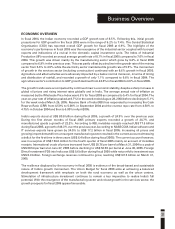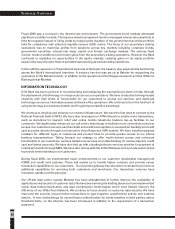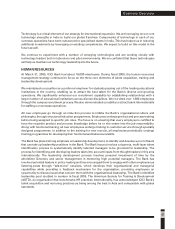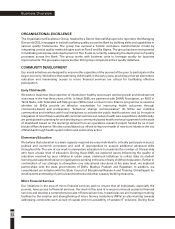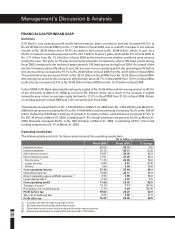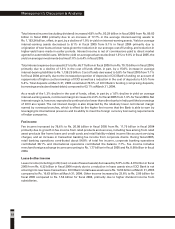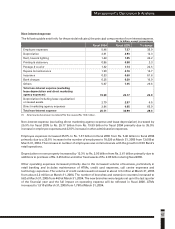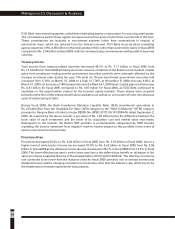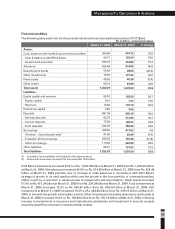ICICI Bank 2005 Annual Report Download - page 41
Download and view the complete annual report
Please find page 41 of the 2005 ICICI Bank annual report below. You can navigate through the pages in the report by either clicking on the pages listed below, or by using the keyword search tool below to find specific information within the annual report.
39
Market Risk
Market risk is the risk of loss resulting from changes in interest rates, foreign currency exchange rates,
equity prices and commodity prices. Our exposure to market risk is a function of our trading portfolio,
mandated government securities portfolio, asset-liability management activities and our role as a financial
intermediary in customer-related transactions. The objective of market risk management is to minimise
the impact of losses due to market risk, on earnings and equity capital.
Market risk policies include asset-liability management (ALM) policies and policies for the trading
portfolio. The Asset Liability Management Committee (ALCO) of the Board of Directors stipulates liquidity
and interest-rate risk limits, monitors risk levels by adherence to set limits and articulates the organisation’s
interest rate view. A separate set of policies for the trading portfolio address issues related to investments
in various trading products. RMG exercises independent control over the process of market risk
management and recommends changes in processes and methodologies for measuring market risk.
Interest rate risk is measured through the use of re-pricing gap analysis and duration analysis. Liquidity risk
is measured through gap analysis. We ensure adequate liquidity at all times through systematic funds
planning and maintenance of liquid investments as well as by focusing on more stable funding sources
such as retail deposits. We mitigate our exposure to exchange rate risk by stipulating daily stop-loss limits
and position limits.
The Treasury Middle Office Group monitors the asset-liability position under the supervision of the ALCO.
It also monitors treasury activities, including determining compliance with various exposure and dealing
limits, verifying the appropriateness and accuracy of various transactions, processing these transactions,
tracking the daily funds position and all treasury-related management and regulatory reporting.
Operational Risk
Operational risk can result from a variety of factors, including failure to obtain proper internal
authorisations, improperly documented transactions, failure of operational and information security
procedures, computer systems, software or equipment, fraud, inadequate training and employee errors.
We attempt to mitigate operational risk by maintaining a comprehensive system of internal controls,
establishing systems and procedures to monitor transactions, maintaining key back-up procedures and
undertaking regular contingency planning. Processes have been categorised based on the frequency and
impact of the operational risk that they carry. Based on this classification, mitigants have been outlined to
reduce the risk. We have initiated work on modeling the impact of losses arising out of operational risk
inherent in different processes as part of our approach towards the new Basel Capital Accord.
The Middle Office Group monitors adherence to credit and investment procedures. The Internal Audit
Group undertakes a comprehensive audit of all business groups and other functions, in accordance with a
risk-based audit plan. This plan allocates audit resources based on an assessment of the operational risks
in the various businesses. We have been a pioneer in the implementation of a risk-based audit
methodology in the Indian banking sector. The Internal Audit Group conceptualises and implements
improved systems of internal controls to minimise operational risk.
TREASURY
Effective fiscal 2004, we restructured our treasury operations to separate the balance sheet management
function, the client-related corporate markets business and the proprietary trading activity. The balance
sheet management function and proprietary trading activity now form part of the Corporate Centre, while
the client-related corporate markets business formed part of the Wholesale Banking Group in fiscal 2005
and is now being reorganised into the Global Markets Group.
Business Overview
Dickenson Tel: 022-2625 2282




